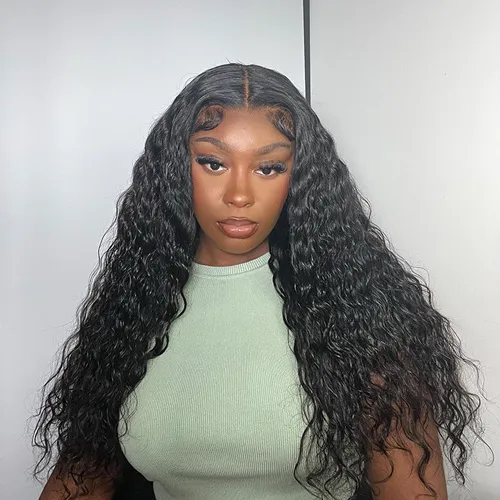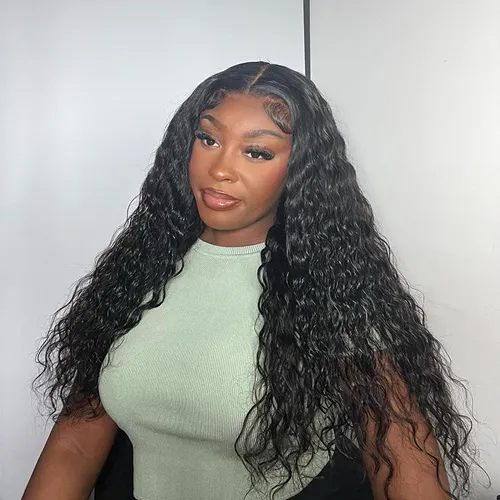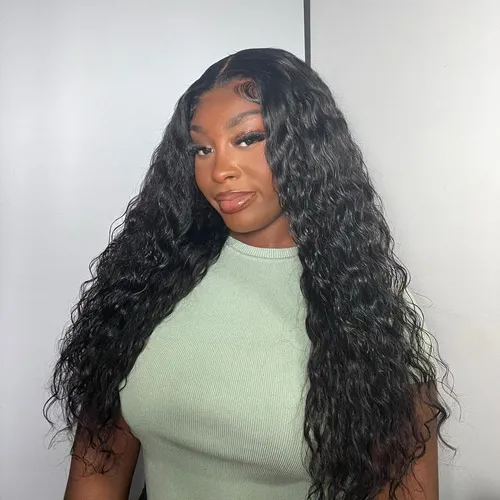The Ultimate Guide to Wet and Wavy Wigs

Wet and wavy wigs have taken the beauty world by storm, offering versatility, ease of use, and a stunning aesthetic that can transition from sleek and sophisticated to voluptuously wavy with just a sprinkle of water. These wigs are beloved for their ability to mimic the natural hair’s reaction to water, providing the wearer with two styles in one wig. Made from either synthetic fibers or human hair, they cater to a wide range of preferences and budgets.

Wet and wavy wigs.
a. Types.
Human hair wigs:
Offer the most natural look, feel, and durability. They can be treated just like your own hair, allowing for heat styling and color treatments.
Synthetic wigs:
These are more affordable and require less maintenance. However, they might not last as long as human hair wigs and typically don’t offer the same styling versatility.
b. Texture and length.
Wet and wavy wigs come in various textures, from loose waves to tight curls, and in lengths from short bobs to waist-length manes. The choice depends on personal preference and the look you aim to achieve.

What is unique about wet and wavy wigs?
Wet and wavy wigs hold a unique position in the world of hairpieces and extensions, standing out for their versatility, natural appearance, and ease of styling. These wigs are designed to offer wearers two distinctly different looks with the same piece: a sleek, straight style when dry, and a beautiful, wavy pattern when wet. This chameleon-like ability is just the start of what makes wet and wavy wigs special. Below, we delve into the features that set these wigs apart.
1. Dual styling options.
The most notable feature of wet and wavy wigs is their dual styling capability. With minimal effort—essentially just the application of water. These wigs can transition from a straight to a wavy texture, giving the wearer flexibility in their look. This feature is particularly appealing for those who enjoy changing their style frequently but want to avoid the damage caused by heat styling tools.
2. Natural appearance.
Wet and wavy wigs often boast a very natural appearance. When made from high-quality human hair, these wigs mimic the natural response of hair to moisture, resulting in waves and curls that look as though they’ve been styled by nature itself. Even synthetic versions are designed to imitate this natural phenomenon closely, offering a believable texture and sheen that can fool even the keenest eye.
3. Minimum upkeep.
Despite their sophisticated appearance, wet and wavy wigs are surprisingly low maintenance. The transition from straight to wavy does not require any heat styling tools, hair products, or professional services. A spray bottle filled with water or a mix of water and leave-in conditioner is typically all that’s needed to activate the waves, making these wigs a fantastic option for those seeking a low-effort, high-impact style.
4. Flexibility in design.
Beyond the basic wet and dry looks, these wigs offer a wide range of styling possibilities. Wearers can experiment with different levels of waviness by adjusting the amount of water they use, as well as create updos, braids, and other hairstyles that benefit from the wig’s texture. This versatility makes wet and wavy wigs suitable for various occasions, from casual outings to more formal events.
5. Comfort and wearability.
Manufacturers of wet and wavy wigs often prioritize comfort and wearability, incorporating features like lightweight caps, breathable materials, and adjustable straps into the design. These considerations ensure that the wig can be worn for extended periods without causing discomfort or overheating, which is particularly important for those who wear wigs as a daily hair solution.
6. Durability.
High-quality wet and wavy wigs are designed for durability. Human hair versions, when properly cared for, can last a significant amount of time even with regular wear and styling. Synthetic options, while generally not as long-lasting as their human hair counterparts, have also seen improvements in durability thanks to advancements in fiber technology.
7. Protects natural hair.
For individuals looking to protect their natural hair from the rigors of daily styling, heat damage, and environmental stressors, wet and wavy wigs offer an attractive solution. By covering the natural hair, these wigs allow it to rest and regenerate, potentially leading to healthier hair growth over time.

What are some ways to make your wet and wavy wig look more stylish and attractive?
Wet and wavy wigs offer a versatile and dynamic approach to hairstyling, blending the convenience of a wig with the natural appeal of varying textures. To elevate the style and attractiveness of your wet and wavy wig, consider the following tips and techniques:
1. Hydration and conditioning.
Deep condition:
Regular deep conditioning treatments can rejuvenate the wig’s hair, enhancing its natural wave pattern and adding luster. For human hair wigs, use quality hair masks or natural oils; for synthetic, look for products specifically designed for synthetic fibers.
Leave-in conditioner:
Applying a leave-in conditioner can help maintain the moisture balance, keeping the waves defined and frizz at bay.
2. Proper detangling.
Gently detangle the wig when it’s partially wet using a wide-tooth comb or your fingers. Start from the tips and gradually work your way up to the roots. This minimizes breakage and maintains the integrity of the waves.
3. Experiment with different wet looks.
The amount of water or leave-in conditioner you use can dramatically change the wig’s appearance. For subtle waves, lightly mist the wig. For more pronounced waves, wet the hair more thoroughly. This experimentation can help you find the perfect balance for various occasions.
4. Styling products.
Utilize mousse, gel, or curl-enhancing creams designed for wet and wavy textures to define and separate the waves or curls. Remember, a little goes a long way, especially with synthetic wigs, as too much product can lead to buildup.
5. Air dry strategically.
After applying your product of choice, let the wig air dry. You can scrunch the hair gently with your hands to encourage the curls or let it hang naturally for a more subdued wave.
6. Heat styling (for human hair wigs)
While one of the appeals of wet and wavy wigs is their low-maintenance styling, using a diffuser attachment on a blow dryer can enhance the wig’s natural texture without causing damage. Ensure you use a heat protectant beforehand.
For a sleek look, carefully flat-iron the hair when dry, then add water or leave-in conditioner to revert to waves when desired.
7. Trim and layers.
A trim or layered cut can add volume and dimension to your wig, making the waves stand out more. Consider taking your wig to a professional stylist who has experience with wigs to achieve a flattering shape that suits your face.
8. Accessorize.
Headbands, scarves, and hair clips not only add a stylish touch but can also help in managing your wig and keeping it in place. Experiment with different accessories to match your outfit and occasion.
9. Color and highlights.
Adding color or highlights can enhance the texture of the wig, making the waves pop. For human hair wigs, consider professional coloring to ensure it’s done correctly. Some synthetic wigs come in balayage or highlighted styles, which can offer a similar effect without the commitment.
10. Proper storage.
Keeping your wig properly stored on a wig stand or mannequin head when not in use can help maintain its style and reduce the need for frequent restyling. Avoid storing it in damp or humid areas to prevent frizz and tangling.
Troubleshooting common issues.
Wet and wavy wigs, while versatile and beautiful, can encounter several common issues during their lifespan. Understanding how to troubleshoot these problems can extend the life of your wig and keep it looking its best. Here are solutions to some of the most frequent challenges:
1. Tangling and matting.
a. Cause:
Friction from wear, lack of moisture, or not detangling properly.
b. Solution:
Use a wide-tooth comb or a wig brush to gently detangle the wig, starting from the ends and working your way up to the roots to prevent unnecessary shedding. Regularly apply a light leave-in conditioner to maintain moisture and reduce tangling. For synthetic wigs, a detangling spray made specifically for synthetic hair can help.
2. Loss of wave pattern.
a. Cause:
Over-styling, excessive brushing, or improper drying methods.
b. Solution:
To revive the wig’s natural wave pattern, lightly dampen it with water and apply a curl-defining cream or mousse. Scrunch the hair gently to encourage the waves. Allow the wig to air dry or use a diffuser attachment on low heat if you’re in a hurry. Avoid brushing the wig when it’s dry, as this can disrupt the wave pattern.
3. Dryness and frizz.
a. Cause:
Lack of moisture, exposure to harsh environments, or using the wrong hair care products.
b. Solution:
Implement a hydration routine that includes regular washing with a sulfate-free shampoo and deep conditioning. For human hair wigs, natural oils like argan or coconut oil can add shine and reduce frizz. For synthetic wigs, a lightweight wig-specific conditioner or fabric softener mix can add moisture back into the fibers. Always let the wig air dry whenever possible.
4. Shedding.
a. Cause:
Rough handling, brushing too aggressively, or a loose weft.
b. Solution:
Be gentle when washing and styling your wig. Use a soft-bristle brush or comb specifically designed for wigs. If the wig is constructed with a lace base, ensure that you’re not applying too much tension near the delicate lace areas. If shedding persists, consider taking the wig to a professional who can reinforce the wefts or replace the lace if necessary.
5. Odor retention.
a. Cause:
Not drying the wig properly, using too much product, or not cleaning it regularly.
b. Solution:
Ensure the wig is completely dry after washing – moisture can lead to mildew and unwanted smells. Avoid applying excessive amounts of hair products, as buildup can also cause odors. Wash your wig regularly, but not too frequently, as overwashing can lead to dryness. A light spritz of wig or fabric freshener between washes can help keep it smelling nice.
6. Losing its shine.
a. Cause:
Wear and tear, the buildup of products, or exposure to heat.
b. Solution:
For human hair wigs, a light application of a silicone-based serum can add shine. For synthetic wigs, washing gently to remove product buildup and using a wig-specific conditioner can help restore luster. Avoid exposing your wig to high temperatures, including hot water, as this can dull the fibers.
7. Difficulty styling.
a. Cause:
Stiffness from product buildup or aging fibers.
b. Solution:
Washing your wig to remove buildup can restore flexibility. For human hair wigs, a deep conditioning treatment might be necessary. For synthetic wigs, a fabric softener bath can help soften fibers, making them easier to style. Remember to always follow any styling efforts with proper drying and storage to maintain the desired style.
Why you should come to Recool Hair to get your wet and wavy wig?
Choosing Recool Hair for your wet and wavy wig purchase is a decision that promises quality, variety, and customer satisfaction. At Recool Hair, we specialize in providing premium wet and wavy wigs crafted from the finest human hair, ensuring a natural look and feel that is second to none. Our wigs are meticulously designed to offer both beauty and versatility, allowing you to effortlessly switch between sleek, straight styles and luxurious waves with just a sprinkle of water.
Beyond the exceptional quality of our products, we pride ourselves on our attentive customer service, ensuring that every client finds their perfect match and feels supported throughout their buying journey. With Recool Hair, you’re not just buying a wig; you’re investing in a piece that will enhance your beauty and confidence, backed by a commitment to excellence that distinguishes us in the marketplace.
